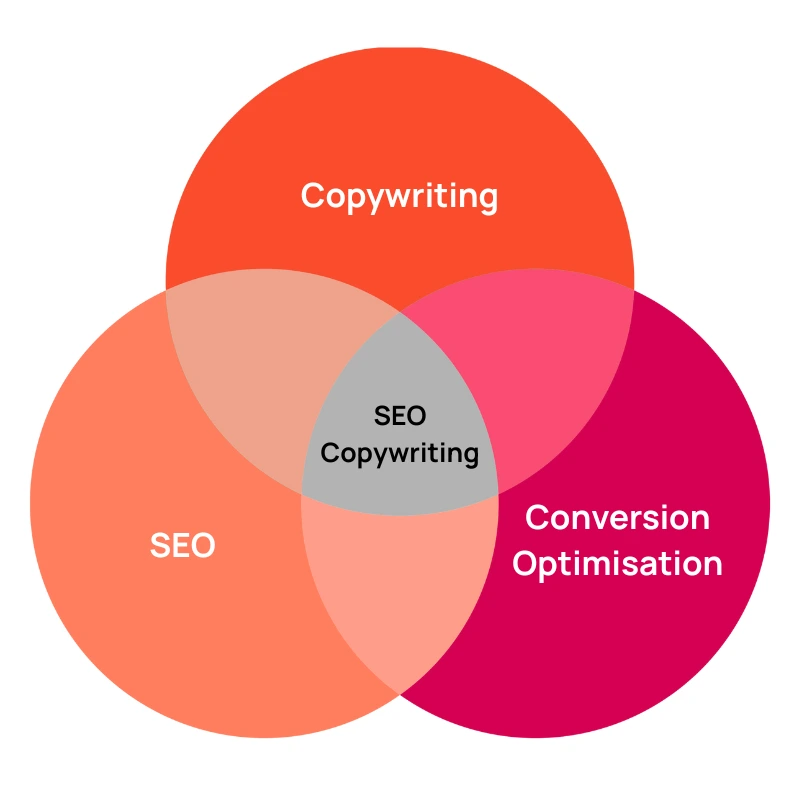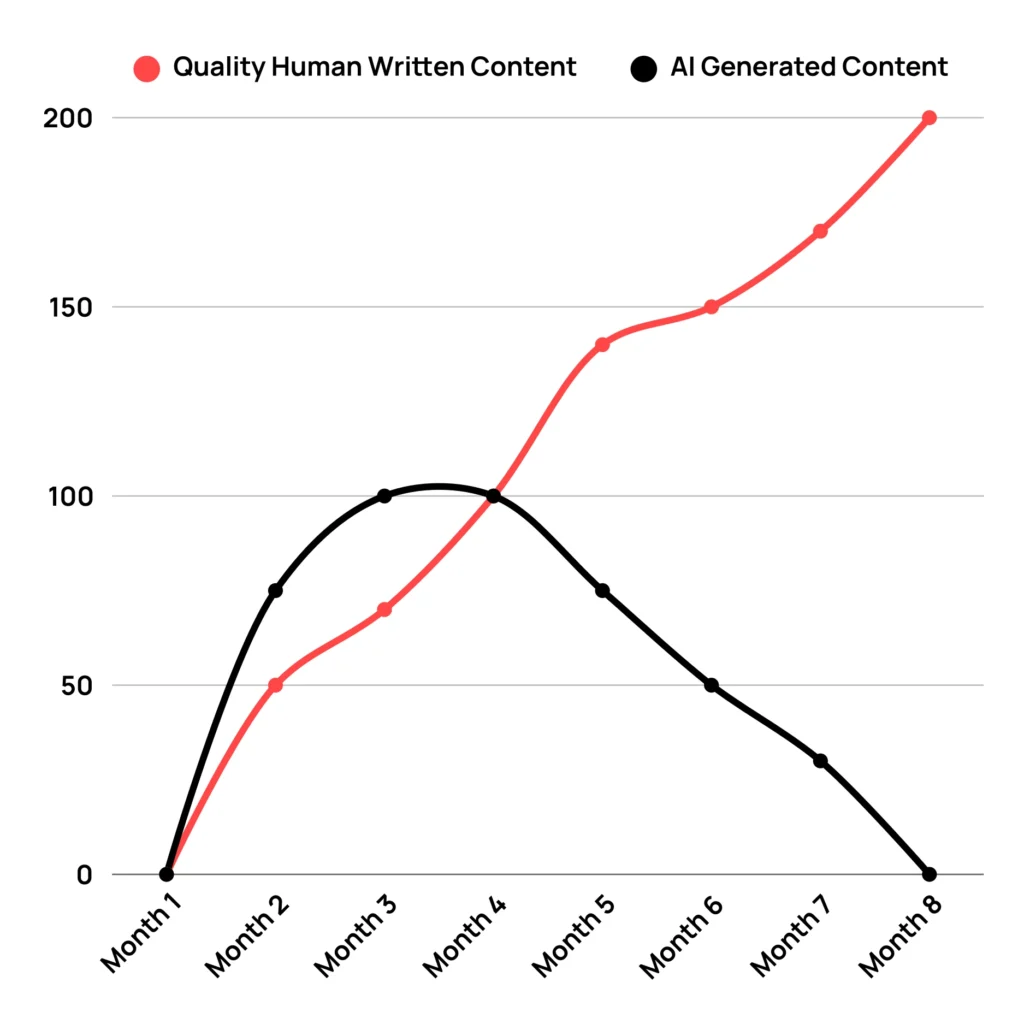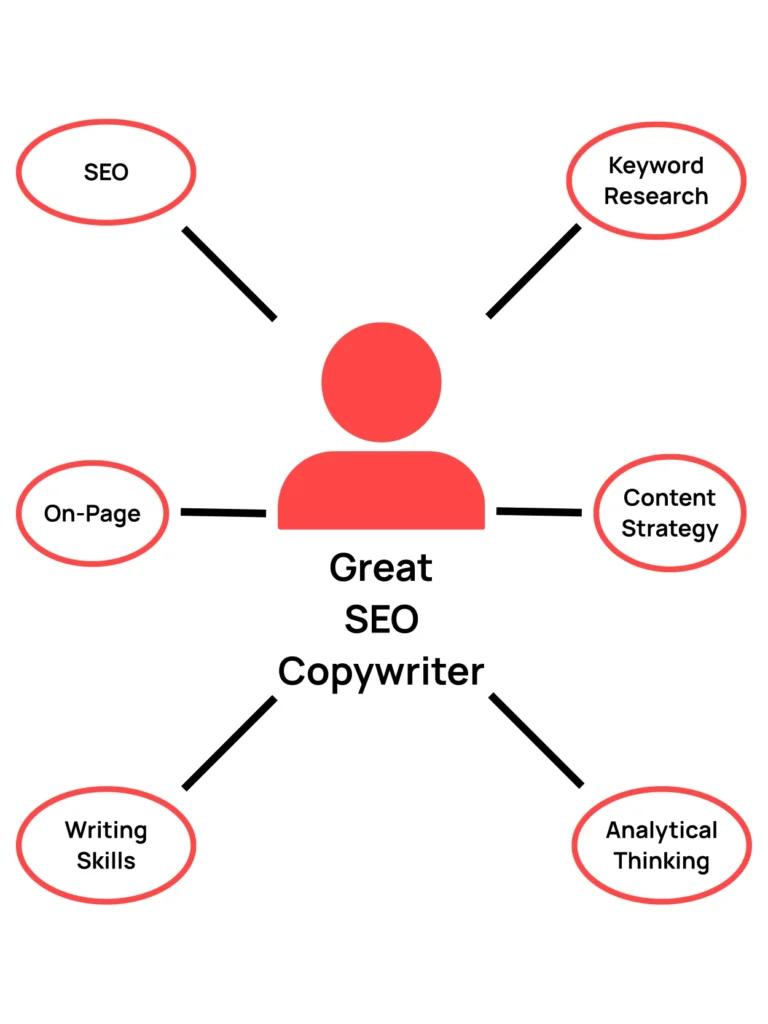Home » Guide To SEO Copywriting
I still remember sitting across from a client who looked genuinely confused when I mentioned SEO copywriting. “Can’t we just get the intern to write something and sprinkle in some keywords?” he asked.
It’s a common misunderstanding. Many businesses view SEO copywriting as simply normal writing with some keywords thrown in. But that approach is exactly why so many websites struggle to gain traction in search results while also failing to connect with readers.
The truth is that proper SEO copywriting is one of the most valuable yet misunderstood skills in digital marketing today. It’s the careful marriage of technical SEO knowledge with persuasive writing ability. And it’s surprisingly rare to find people who excel at both.
In my experience working with dozens of businesses across the UK, the quality of your website copy often makes the difference between thriving online and barely surviving. It’s the line between appearing on page one of Google versus page ten, and between converting visitors into customers versus watching them click away within seconds.
SEO copywriting isn’t just about getting traffic. It’s about getting the right traffic and then persuading those visitors to take action. It’s the bridge between visibility and conversion that so many businesses are missing.
Let’s dig into what makes effective SEO copywriting work, why most AI-generated content fails, and how to create content that satisfies both search engines and human readers.

SEO copywriting is the strategic practice of creating content that ranks well in search engines while effectively engaging readers and driving them to take specific actions.
It sits at the intersection of several disciplines: traditional copywriting (persuasive writing), search engine optimisation (technical SEO), content marketing, and user experience. This combination is precisely what makes it uniquely powerful but also challenging to master.
What separates true SEO copywriting from basic content creation is its dual focus. Poor SEO copy might rank initially but fail to engage readers once they arrive. Conversely, beautifully written content that fails to consider SEO principles may never find an audience at all.
SEO copywriting is really a unique skill because you need to be able to not just explain topics in a really clear and precise way but you also need to engage a reader and hit all of the algorithmic SEO functionality that you need to be able to rank in a really good position. There are only a few people I’ve met who can actually do that really well.
The biggest challenge lies in the personal preference and also the type of vertical or business you’re writing for. Someone who might be brilliant at writing travel and tourism content could completely struggle when writing B2B SaaS content for a brand trying to build their subscription model. This vertical specialisation is something that doesn’t always come across in my experience working with copywriters.
“Just use AI to write our blog posts.” I hear this suggestion constantly these days, and I understand the appeal. Who wouldn’t want to push a button and get instant content that ranks?
But here’s the thing – I’ve actually tested this extensively. I’ve run real experiments with various websites and content types, publishing pure AI-generated content to see what happens. And what I’ve found matches what many SEO professionals are now reporting: purely AI-written content almost always fails for sustainable SEO.
The pattern is strikingly consistent. The AI-written articles might rank initially and bring in traffic for the first week or two. Then, almost like clockwork, they disappear from search results as Google and other search engines identify them as AI-generated.
I’ve seen this happen repeatedly. The content gets an initial burst of visibility, then suddenly vanishes from search results entirely. Not dropping a few positions – completely gone.
The development of AI tools to this point, and maybe for future reference as well, may not be able to cover or take the work of a really good SEO copywriter. What I’m seeing is that in most cases, if you answer a particular question and it’s written totally by AI, you’ll get an initial one week or two weeks of rankings and potentially traffic before Google realises or other search engines realise that this is AI content and it just disappears.
This doesn’t mean AI has no place in content creation. I find it incredibly useful for research, outlining, generating ideas, and even drafting certain sections. But using AI as a complete replacement for human expertise and writing skill is where many businesses go wrong.
The businesses that seem to be succeeding with AI are those using it as a collaborator rather than a replacement. They use AI to handle the heavy lifting of initial research and drafting, then bring in human expertise to add unique insights, verify information, restructure where needed, and add that authentic voice that AI just can’t quite nail yet.

So what makes someone truly effective at SEO copywriting? It’s a rare combination of skills that blend technical knowledge with creative writing abilities.
For starters, great SEO copywriters have a sixth sense for their audience. They go beyond basic demographic information to really understand how their readers think, what keeps them up at night, and exactly how they search for solutions. This deep audience understanding guides everything from keyword selection to content structure and tone of voice.
They also have an uncanny ability to detect search intent. When someone types “best running shoes,” are they looking to buy immediately, or are they just starting their research? Do they want a comparison list, detailed reviews, or quick recommendations? Great SEO copywriters can analyse the top-ranking pages for a target keyword and immediately understand what type of content Google considers most relevant to that query.
But technical SEO knowledge alone doesn’t make a great copywriter. The real magic happens when that technical foundation combines with persuasive writing ability. The skill to craft compelling headlines, write engaging introductions, tell captivating stories, and guide readers toward a specific action is equally crucial.
Perhaps most importantly, SEO copywriting requires vertical-specific knowledge. This is something I’ve noticed repeatedly that doesn’t get discussed enough. A writer who creates excellent content for travel websites might struggle terribly with B2B SaaS content. Someone who writes compelling health and wellness copy might flounder when tackling financial services.
For businesses or brands wanting to engage with a copywriter or agency, a diversification of skills and writing styles is really important. This doesn’t always come across from my personal experience working directly with copywriters. The most successful outcomes happen when businesses work with writers who either specialise in their industry or demonstrate a genuine ability to research and understand the specific vertical they’re writing for.

I’m not a fan of rigid formulas and templates for SEO copywriting. The moment we all follow the same structure is the moment we all start creating generic, forgettable content. Instead, I’ve found that effective SEO copy comes from understanding core principles and adapting them thoughtfully to each unique situation.
That said, having a loose framework helps ensure you don’t miss anything important. So here’s how I typically approach creating SEO content that actually delivers results:
I always start with deep research. This is non-negotiable. I need to understand what the audience cares about, what language they use, what questions they’re asking, and what’s already ranking for my target keywords. I’ll analyse the top-ranking pages to understand search intent, identify content gaps, and find opportunities to create something genuinely better.
When planning the content, I think carefully about structure. How can I organise information to make it both search-friendly and reader-friendly? What questions need answering? What objections need addressing? I’ll create an outline that flows logically and covers the topic comprehensively while maintaining focus on my primary keyword targets.
The writing itself should blend creativity with strategic optimisation. I craft headlines that include target keywords while genuinely attracting interest. I write introductions that hook readers immediately while establishing relevance. Throughout the content, I weave in keywords naturally, use descriptive subheadings, incorporate relevant internal links, and optimise images with descriptive alt text.
After drafting, the editing phase becomes critical. Beyond checking for grammar and spelling, I review for SEO elements, readability, factual accuracy, and conversion optimisation. Am I effectively guiding readers toward the desired action? Does the content deliver on the promise of my headline?
Finally, I treat publication as the beginning, not the end. I monitor how the content performs in terms of rankings, traffic, engagement, and conversions. I use this data to make iterative improvements over time, keeping content fresh and competitive.
E-E-A-T is also really massive. You just don’t write copy by any random person. It should be verified, the information should be clear, and there should be somebody who’s an expert within each field you’re writing for to verify the information and add that stamp of authority and expertise.
Google’s E-E-A-T guidelines (Experience, Expertise, Authoritativeness, and Trustworthiness) have become increasingly important for SEO success, and I think that’s actually a good thing for consumers and legitimate businesses alike.
Some of the most challenging areas for copywriting include healthcare, which is a minefield of potential misinformation. I believe copywriters, like journalists, have an obligation to provide accurate information, which is where proper research becomes essential.
Copywriting can’t just be off-the-cuff. It needs to be deeply researched, backed by data and statistics, and verified by independent sources who are relevant experts in that particular field. This verification process isn’t just a box-ticking exercise – it’s fundamental to creating content that both search engines and readers will trust.
I’ve seen too many businesses treat E-E-A-T as just another SEO tactic, when it’s actually about building genuine authority and trust. Having content created or reviewed by subject matter experts, including author biographies that highlight relevant credentials, sharing specific examples that demonstrate hands-on experience – these aren’t just good for SEO, they’re good business practices that build credibility with your audience.
And really, this is where the rubber meets the road with separating quality SEO copywriting from mediocre efforts. Anyone can stuff some keywords into content, but creating material that genuinely demonstrates expertise and builds trust requires a deeper commitment to quality and accuracy.
Let’s get tactical for a moment and talk about some specific techniques that I’ve found consistently deliver results. These aren’t complicated “hacks” or tricks – they’re just solid approaches that work time and again.
First, focus on strategic keyword placement rather than obsessing over keyword density. I’ve seen writers tie themselves in knots trying to achieve some mythical “perfect” keyword density, when what really matters is including your target terms in the right places: your main headline, early in the content, in some of your subheadings, image alt text, and meta description. Beyond that, focus on making the content read naturally. If it sounds awkward when read aloud, it’s probably over-optimised.
One thing I’ve learned from heat-mapping studies is that online reading patterns are wildly different from print reading. Most visitors scan content in an F-pattern – they read across the top, scan down the left side, and occasionally read across again. Knowing this completely changes how you should structure web content. Break information into clear sections with descriptive headlines. Keep paragraphs shorter than you would in print. And use visual breaks like images or formatting to prevent the dreaded “wall of text” that sends readers fleeing.
Modern search algorithms are remarkably sophisticated at understanding topics, not just matching keywords. This means you should aim for comprehensive coverage rather than just repeating the same phrases. When writing about “digital marketing strategy,” naturally incorporate related concepts like “marketing goals,” “audience targeting,” and “performance measurement” without forcing them in. This topical comprehensiveness signals authority to search engines while providing genuine value to readers.
Meta descriptions might not directly impact rankings, but they dramatically affect click-through rates. Think of them as free advertising space on the search results page. A compelling meta description that includes your keyword, clearly communicates value, and creates curiosity can significantly boost clicks. I’ve personally seen businesses increase organic traffic by 20-30% simply by improving meta descriptions, without changing anything else. That’s an incredible return on a relatively small investment of time.
Not all content serves the same purpose, and I’ve found that different types of pages need different approaches to SEO copywriting.
Service and product pages have unique challenges. They need to rank for commercial terms while also convincing visitors to take action. I find that successful service pages typically lead with clear, benefit-focused headlines that incorporate primary keywords naturally. They quickly address the visitor’s likely pain points or goals, provide enough detail to satisfy search intent and establish credibility, and close with clear calls to action. The trick is including enough content for search engines without diluting the conversion focus.
Blog content works differently. It’s typically targeting informational searches and building topical authority rather than driving immediate conversions. When writing blog posts for SEO, I start by matching search intent precisely. What exactly is someone looking for when they search this term? Then I aim to create something more comprehensive and valuable than what already ranks – not just longer, but genuinely better. Internal linking becomes crucial here, connecting visitors to related content and creating a web of relevance that both readers and search engines can follow.
Local SEO presents its own special considerations. When writing for businesses targeting local customers, I don’t just stuff location terms everywhere. Instead, I incorporate them naturally throughout the content, in headings, meta descriptions, and alt text. But beyond just mentioning locations, truly effective local content demonstrates genuine local knowledge – references to local landmarks, acknowledgment of regional challenges, specific details about serving the local community.
Product descriptions get overlooked in SEO strategies, but they’re huge opportunities, especially for ecommerce sites. The cardinal sin is using manufacturer boilerplate that appears on dosens of other websites. Instead, create unique descriptions that not only include relevant keywords but actually help customers understand how the product solves their problems. Focus on benefits, not just specifications, and address likely questions and objections directly.
One question I get all the time is “How do we know if our SEO copywriting is actually working?” It’s a great question because without proper measurement, you’re just guessing.
I find that looking at a blend of search metrics, engagement metrics, and conversion metrics gives the clearest picture of performance.
On the search side, rankings still matter, of course. I track positions for primary and secondary keywords to see movement over time. But rankings alone don’t tell the whole story. Organic traffic shows whether your rankings are actually driving visitors. And search click-through rate, available in Google Search Console, reveals whether your titles and meta descriptions are compelling enough to earn clicks when you do rank.
I’ve seen pages ranking in position three with abysmal click-through rates because their meta descriptions were boring or unclear. And I’ve seen pages in position five outperforming position three listings because they had more compelling titles and descriptions. Sometimes improving your CTR from 2% to 6% can drive more traffic than moving from position 5 to position 3.
Once visitors arrive, engagement metrics reveal whether your content meets their needs. Average time on page shows whether people are actually reading or watching your content rather than bouncing immediately. Scroll depth tracking can show how far down the page people typically read. And for blog content, internal click rates show whether visitors are exploring more of your site or leaving after viewing just one page.
Ultimately, conversion metrics connect your content to business outcomes. Depending on your goals, these might include lead form submissions, newsletter signups, product purchases, or phone calls. Attribution can get complex, especially for businesses with longer sales cycles, but even basic goal tracking in Google Analytics can provide valuable insights.
The most valuable approach combines these metrics to tell a complete story. A page might have strong rankings and traffic but poor engagement and conversions, suggesting the content isn’t delivering on the promise of its title. Or you might see excellent engagement and conversion rates but minimal traffic, indicating a targeting or visibility issue rather than a content quality problem.
Let’s talk about what might be the biggest challenge in SEO copywriting: maintaining the delicate balance between creative, engaging writing and technical optimisation requirements.
I’ve found that thinking of SEO requirements as creative constraints rather than limitations helps produce better results. Just as a poet might choose to write a sonnet with its specific structure and rhyme scheme, an SEO copywriter chooses to work within certain parameters while still creating something original and valuable.
Working with subject matter experts presents both challenges and opportunities for this balance. Many experts provide incredibly valuable insights but aren’t trained in writing for online audiences or SEO. Rather than simply taking their raw content and “SEO-ifying” it (which often ruins the authentic voice), I prefer a collaborative approach. Interview experts to extract their knowledge, incorporate their unique perspectives and examples, then shape the content to be both search-friendly and authentic to their expertise.
When facing specific technical SEO requirements, look for creative ways to satisfy them without compromising quality. If you need to incorporate a somewhat awkward keyword phrase, could it work naturally in a quote or as part of a hypothetical question? If you need to reach a certain content length for competitive reasons, can you add genuinely valuable sections like practical examples or helpful context rather than just fluff?
Remember that search engines ultimately want what users want: valuable, relevant content that genuinely answers their queries. The most sustainable approach to SEO copywriting focuses first on creating exceptional value for the reader while skillfully incorporating the technical elements that help search engines recognise and reward that value.
So where is all this heading? I’ve been in this industry long enough to see dozens of “revolutionary changes” come and go. Remember when mobile was going to completely transform SEO? Or when voice search was supposedly making keywords obsolete?
The reality is usually less dramatic. SEO evolves rather than transforms overnight. And I think we’re in another evolution phase now.
AI is the obvious elephant in the room. I get asked about it constantly. “Will AI replace copywriters?” “Should we just use AI for all our content now?”
My answer might surprise you. I don’t think AI is either the saviour or destroyer of SEO copywriting. It’s just another tool. I believe the future belongs not to those who either reject AI entirely or rely on it completely, but to those who thoughtfully integrate it into their processes.
The smartest content creators I know are already using AI as a research assistant, outline generator, and first-draft tool. But they’re still applying their human expertise, creativity, and judgement to the process. They’re editing heavily, adding unique insights, and making sure the final product has that human touch that AI still can’t quite replicate.
I’m also watching how voice search continues to shape content. People talk differently than they type. They use longer phrases, more natural language, and ask direct questions. “Best Italian restaurant London” becomes “What’s the best Italian restaurant near me that’s open right now?” This shift demands more conversational content that directly answers specific questions.
And what about E-E-A-T? Google’s emphasis on Experience, Expertise, Authoritativeness, and Trustworthiness isn’t going anywhere. In fact, I’m seeing it become even more important, especially for topics that impact wellbeing or finances.
This isn’t just some technical SEO consideration. It’s about the genuine responsibility content creators have to their audiences. Misinformation spreads far too easily online, and search engines are (rightfully) trying to combat that by elevating trustworthy sources.
The winners in this evolving landscape won’t be those with the most technical SEO tricks or the biggest content budget. They’ll be the ones who consistently create genuinely valuable content that serves real people while being thoughtfully optimised for discovery.
That’s not a revolutionary prediction, I know. But in an industry often chasing the next shiny object, sometimes the most powerful insight is that the fundamentals still matter most.
Let me ask you something. When was the last time terrible website copy convinced you to buy something? Or when did you last think, “This content is so poorly written and unhelpful, I should definitely hire this company”?
Never, right?
Yet I still encounter businesses treating their website content as an afterthought or a box-ticking exercise. They’ll spend thousands on web design and PPC campaigns but balk at investing in quality copy for their most important pages.
It’s a massive missed opportunity. SEO copywriting, when done well, isn’t just another marketing expense. It’s a business asset that delivers value 24/7, month after month, often for years.
I’ve worked with businesses who replaced generic, keyword-stuffed product descriptions with genuinely helpful, well-optimised content and saw conversion rates double. I’ve seen companies invest in comprehensive, authoritative guides that still drive qualified leads three years later with zero additional investment.
What other marketing channel keeps working for you without ongoing costs? PPC stops the moment you pause the campaign. Social media requires constant feeding. Even email marketing needs regular new content.
But that blog post ranking #1 for your target keyword? It’s still sending customers your way months or years later.
Look, there’s no magic formula here. Creating content that both ranks well and converts effectively takes skill, time, and effort. Whether you’re developing these capabilities in-house or partnering with specialists, it requires real investment.
But for businesses that make that investment? The returns can be exceptional. Higher rankings. More qualified traffic. Better engagement. Stronger conversion rates. Improved brand perception.
That’s the power of great SEO copywriting. Not just ranking, not just traffic, but actual business results that impact your bottom line.
So is it worth it? For businesses serious about sustainable online growth, absolutely.
Ready to transform your website content into a powerful tool for attracting and converting your ideal customers? Start building content that ranks in search and drives real business results.
